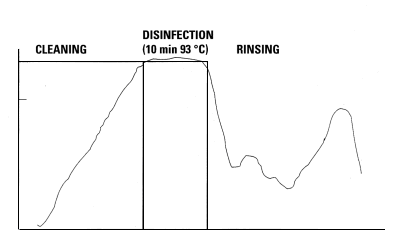Recommendations by the Quality Task Group
|
||||||||||||||
 |
| Fig. 1: RKI- or epidemic programme |
In such cases, a hold time can be programmed at optimal cleaning temperatures. Since alkaline or alkaline-active-chlorine-based ![]() DETERGENTS are used in this programme, a hold time would be recommendable after reaching a temperature of 60 °C. To what extent neutral or low alkaline detergents are suited to the RKI programme must be inferred from the manufacturer’s recommendations. It is important that quick and widespread detachment of all residues take place when using combined cleaning and disinfection.
DETERGENTS are used in this programme, a hold time would be recommendable after reaching a temperature of 60 °C. To what extent neutral or low alkaline detergents are suited to the RKI programme must be inferred from the manufacturer’s recommendations. It is important that quick and widespread detachment of all residues take place when using combined cleaning and disinfection.
For thermal disinfection, the detergent solution is heated to 93 °C. This ![]() TEMPERATURE is maintained for 10 minutes based on the recommendations of the RKI, thus assuring bactericidal, fungicidal, tuberculocidal and virus-inactivating action, including hepatitis B viruses (HBV). Extremely high safety has been incorporated for inactivation of HBV, since not all CSSD staff members will have been vaccinated against HBV.
TEMPERATURE is maintained for 10 minutes based on the recommendations of the RKI, thus assuring bactericidal, fungicidal, tuberculocidal and virus-inactivating action, including hepatitis B viruses (HBV). Extremely high safety has been incorporated for inactivation of HBV, since not all CSSD staff members will have been vaccinated against HBV.
The solution is drained after the combined cleaning and disinfection step. To neutralise the residues of the alkaline detergent solution, which are generally in the range of pH 11 to pH 12.5, and thus enhance rinsing, a ![]() NEUTRALISING AGENT, based on phosphoric acid or organic acids is added to the first rinse water. At least two further rinse cycles follow. The last rinse water, also called final rinse, should be carried out with demineralised water to prevent formation of stains on the instruments and, if the drinking water contains large quantities of table salt, to prevent chloride-induced pitting corrosion due to chloride deposits on the steel instruments after drying. The
NEUTRALISING AGENT, based on phosphoric acid or organic acids is added to the first rinse water. At least two further rinse cycles follow. The last rinse water, also called final rinse, should be carried out with demineralised water to prevent formation of stains on the instruments and, if the drinking water contains large quantities of table salt, to prevent chloride-induced pitting corrosion due to chloride deposits on the steel instruments after drying. The ![]() FINAL RINSE water is heated to a temperature of > 75 °C to kill any microorganisms present, e.g. Pseudomonas aeruginosa and facilitate subsequent drying.
FINAL RINSE water is heated to a temperature of > 75 °C to kill any microorganisms present, e.g. Pseudomonas aeruginosa and facilitate subsequent drying.
Already in the 80s, the call for disinfection of the first flowing solution was restricted to the occurrence of pathogens with epidemic potential. The ![]() MEDICAL OFFICER can decree that under certain circumstances only the RKI or epidemic programme be operated. This means that the washer-disinfector must be able to execute this programme.
MEDICAL OFFICER can decree that under certain circumstances only the RKI or epidemic programme be operated. This means that the washer-disinfector must be able to execute this programme.
1 This paper gives an overview of the RKI or epidemic programme. The Vario programme as well as a programme with a chemical disinfection step for heat-sensitive items will be described in the next edition.
|
||||||||||
© 2006 EFHSS " Updated: 09 May 2005, 18:10 [GMT]